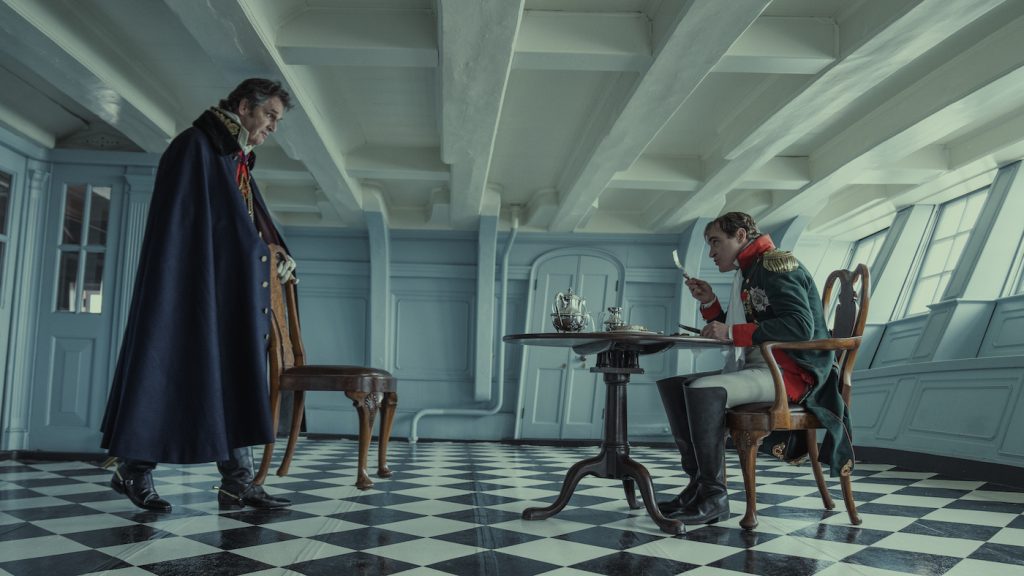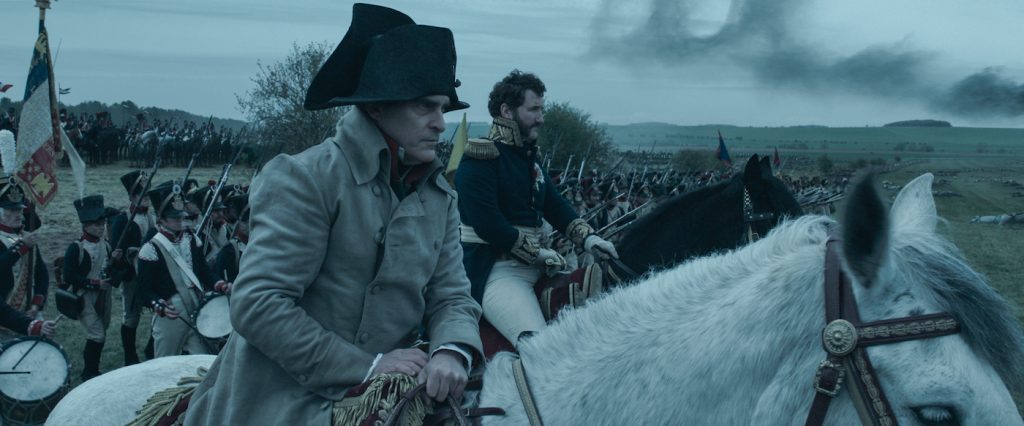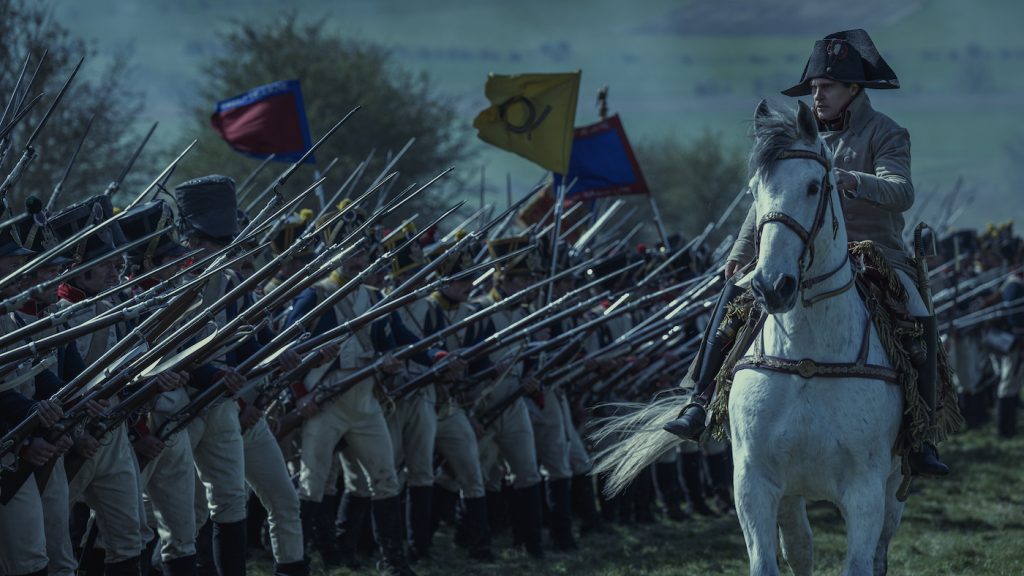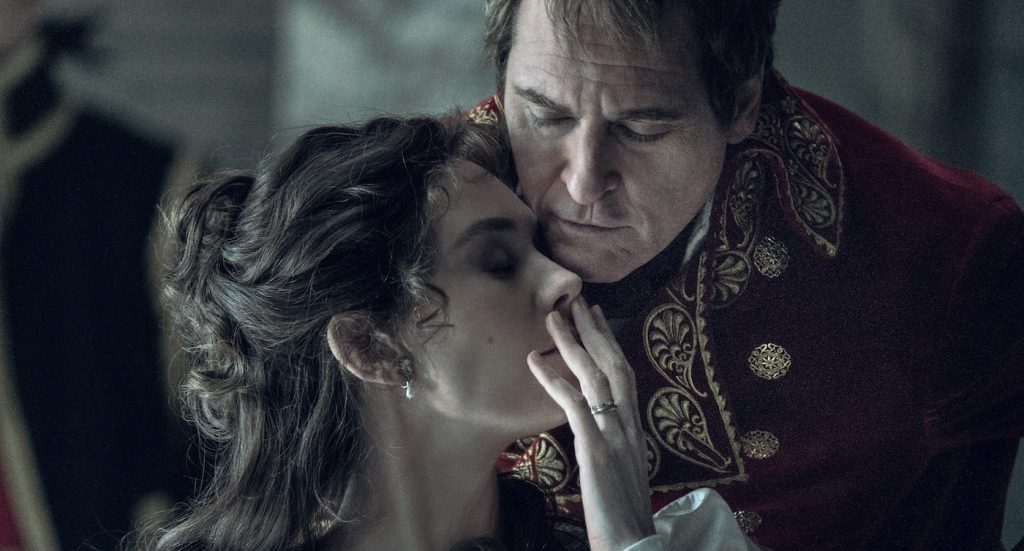“Napoleon” Production Designer Arthur Max and Set Decorator Elli Griff on Bringing Bonaparte’s World to Life
Ridley Scott’s Napoleon takes on the general-turned-emperor who ruled France from 1799 to 1814 and presents him (Joaquin Phoenix) as an indefatigable military strategist but also a tortured everyman obsessed with, and forever a touch spurned by, his wife and subsequent ex-wife, Joséphine (Vanessa Kirby). Running in the background of this love affair are Bonaparte’s imperial conquests, his catastrophic losses in Russia, and finally, his banishment to Elba.
Scott’s portrait highlights a more intimate side of the former emperor, depicting him derailed by aggravation with Joséphine for taking a lover and his worries over who, in their marriage, is the cause of the lack of an heir. But the settings in which both Napoleon’s imperial conquests and his home life play out are purely of the era — grand palaces shot on location (in England, not France) and vast landscapes transformed into colossal battlefields.
Production designer Arthur Max (Gladiator, The Martian), who has worked with Scott for years, looked for neoclassical buildings around London for the film’s location shoots. Like the architecture in France at the time, neoclassical English palaces also relied on Palladian architecture out of Italy. For set decorator Elli Griff (Gladiator, Black Hawk Down), a strong theme of the production was redressing locations as different settings with truckloads of items brought in from France. We had the chance to speak with the pair about using the same location for multiple scenes, creating battlefields for unseen troops, and how this unusual depiction of Napoleon’s character influenced their work.
As far as locations, Blenheim Palace was particularly important. How did you use it to represent multiple locations?
Arthur Max: Mostly for me, it was a set dressing world. We did a bit of construction. We added two fireplaces to the central hall. They were very helpful with us on that score because we wanted to use the main entry hall for many big scenes. But the rest was Elli, to be honest.
Elli Griff: We had all those continuous staterooms at the back of Blenheim to dress. There are a couple of locations where you see Napoleon walking through. There’s his encounter about the peace treaty and his letter being rejected by the English, and how offended he was. There was another set-up of him going to sleep with the young lady to see if he could beget a child with her, and that took him down quite a long passageway, which was a redress of the same stateroom corridor. One day, I think we had four huge dinner parties and a masked ball to dress, so while they were shooting in one area, we were hastily redressing another. Then the unit would scoot over there, and we’d redress the main area again. And they would zip back and forth whilst we were putting in a pre-prepared setup that we’d practiced to cut down as much time as possible.

AM: What I remember was that there was a day the Great Hall was so full of furniture that you couldn’t even walk through it. There were so many revamps. It was like one of those puzzle games where there’s only one space, and you have to move all the pieces around to get where you want to go.
EG: Exactly. That’s what I love about it—art directing that and making it work. There were many comments, ‘What’s all this furniture doing here?’
Elli, in terms of outfitting the set from the Napoleonic era, you had some loans from the Victoria & Albert Museum. Is that right?
EG: In terms of the V&A, we’re very privileged to have access to some of their archives. Obviously deals have to be done, promises have to be made, etc. But the bigger part of the aesthetic, as far as we’re concerned, is that I had a fabulous buyer in Bernard Chedin in Paris, who I worked with many years ago. We’ve all marinated over the years, become more refined and tuned in, and he works so efficiently in getting me as much Napoleonic stuff from Paris that we were going at such a speed I didn’t even get there myself. We were lucky to have truck after truck of the most amazing sets of Imperial and Empire furniture that we could keep moving around, redressing, and recovering. There wasn’t enough furniture in Europe to cater to all the intimate interiors that we had to do. We cleaned out all the UK hire companies. Luckily for us, we have such a good rapport that they were personally buying stuff in to keep us going because we were going at such a speed and multiple units. And France throws off the weirdest vernacular surprises that you’re not expecting.
Like what?
EG: I didn’t realize that the French used to have a water heater that they put in their baths. It was this incredible copper chimney with two little side chimneys. You put all the hot coals in the center; it was taller than the lip of the bath, and air came in one side chimney, and smoke came out the other one. There was enough room to get your legs on either side of it, and it kept the water hot. You’d think, of course, it sounds so logical, but it was made in such a simple vernacular way, all hand-beaten copper with chains on the top to lift it so you didn’t burn your hands. I’d never seen one before, and there certainly isn’t one in a museum. In fact, the French bought it back from us because it was so rare.
AM: Going back to the V&A and them collaborating with us — all I remember was that we came across a red velvet bed, and as far as the V&A was concerned, we couldn’t come within a meter of it. We wanted to use it, but there was no way they were going to let us, so we replicated something. Elli, I think you did a better job than they did.
How did you each approach the battle scenes? What did you need to find to make them work so well?
AM: Muddy fields. Lots of them. Wellington boots, always. And trudging around trying to find some magnificent topographies that would work for imaginary troops that weren’t there. We didn’t have 120,000 troops. We had 500 a day. So you had to design for what wasn’t there as well as what you were putting there. That was a big challenge. And it was a lot of drawings and physical model making and a lot of location scouting in England to find just the right topography and character of ground for horses, for troops, and also the magnificent vistas that you wanted to have. And also finding owners of these properties who were cooperative enough to let us dig great big trenches for the cannons and redoubts that we needed to build.

EG: Research, research, research. From the set decoration department, we designed all of the horse dressing, apart from the leather work and the tack, all of the horse cloths, and all of the emblems, for every single different army. It was a lot of stuff, but I’m very proud of everybody who stayed longer than they should have just to make sure they brought in first-class work. We had an amazing art director, Jess, who designed and had approved all the horse blankets, all the under-blankets, all the accoutrements they’d have, all the standard bearers, all the flag bearers. It goes on and on, depending on what regiment you’re dealing with, and of course, we had to go through them all.

Finally, we see Napoleon here as a somewhat tortured mortal. How did his character inform your work?
Arthur Max: I am a big fan of the 1927 Abel Gance film Napoléon. It’s about five hours, as I seem to remember. It wasn’t a warm, cuddly character at all, but at the same time, the way Ridley handled the character and how Joaquin portrayed him, he was at times quite comical and joyful. I think it lets you inside the character much more than the historical versions we’ve seen before. Do you remember the dining room scene in Fontainebleau, when he crawls under the dining table and seduces Josephine at breakfast? Nobody was prepared for that. It wasn’t scripted. It went off-piste. That was a real joy to watch because it’s quite endearing for what that showed of their relationship. There was a love story, in a very unrequited way, between them that continues as a thread through the narrative. In terms of the production design, I’m just an old-fashioned architectural researcher and try to keep it on course and historically accurate. When it comes to the characterizations, I leave that to people like Ridley, who spend a lot more time thinking about that than I do.

Elli Griff: For me, it is about making the environment quiet enough to cradle them into the scene but also providing enough details to illustrate who they really are or what’s happening at that particular moment. But it’s all led by Arthur and the director, and I’m just there to support and color as much as I can.
AM: With eight or ten cameras daily, and going exterior, interior, through every room in the building, or very elaborate composite sets, it’s creating 360-degree environments for the actors to inhabit, of all sorts of scales and dimensions. It’s challenging, it’s fun. And that’s the joy of our work. Scenic art is just that; it’s an art form. Every scene in the film is a prototype, with Ridley especially. You look at the research, and you think you know what you’re going to do, and you present it to him; he’s already worked out a completely fresh and different way of looking at it that hasn’t been seen before because that’s what he’s about.
Napoleon is in theaters now.
For more on Napoleon, check out these stories:
“Napoleon” Costume Designers Janty Yates & David Crossman on Designing for Coronations and Conquests
Final “Napoleon” Trailer Teases Ridley Scott’s Epic Take on the French Emperor’s Rise & Downfall
Ridley Scott’s “Napoleon” Review Round-Up: A Gripping, Full-Tilt Epic
Featured image: (l to r) Caulaincourt (BEN MILES), Napoleon (JOAQUIN PHOENIX), Marshal Berthier (SCOTT HANDY), Marshal Davout (YOUSSEF KERKOUR) and Marshal Ney (JOHN HOLLINGWORTH) plan for battle in Apple Original Films NAPOLEON, released theatrically by Columbia Pictures.



